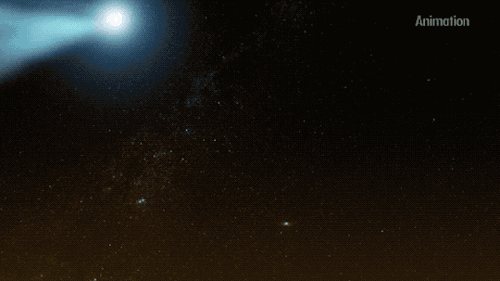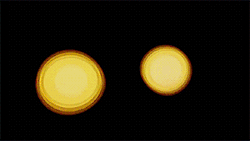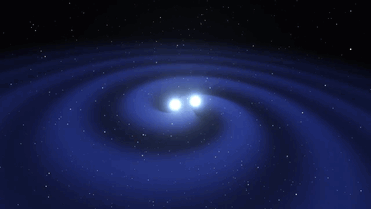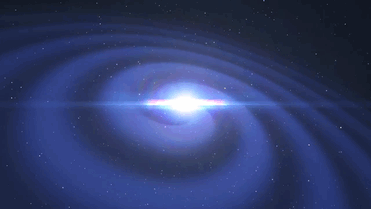Where Every Scroll is a New Adventure
Binary Stars - Blog Posts
The Stellar Buddy System
Our Sun has an entourage of planets, moons, and smaller objects to keep it company as it traverses the galaxy. But it’s still lonely compared to many of the other stars out there, which often come in pairs. These cosmic couples, called binary stars, are very important in astronomy because they can easily reveal things that are much harder to learn from stars that are on their own. And some of them could even host habitable planets!

The birth of a stellar duo
New stars emerge from swirling clouds of gas and dust that are peppered throughout the galaxy. Scientists still aren’t sure about all the details, but turbulence deep within these clouds may give rise to knots that are denser than their surroundings. The knots have stronger gravity, so they can pull in more material and the cloud may begin to collapse.
The material at the center heats up. Known as a protostar, it is this hot core that will one day become a star. Sometimes these spinning clouds of collapsing gas and dust may break up into two, three, or even more blobs that eventually become stars. That would explain why the majority of the stars in the Milky Way are born with at least one sibling.
Seeing stars

We can’t always tell if we’re looking at binary stars using just our eyes. They’re often so close together in the sky that we see them as a single star. For example, Sirius, the brightest star we can see at night, is actually a binary system (see if you can spot both stars in the photo above). But no one knew that until the 1800s.
Precise observations showed that Sirius was swaying back and forth like it was at a middle school dance. In 1862, astronomer Alvan Graham Clark used a telescope to see that Sirius is actually two stars that orbit each other.

But even through our most powerful telescopes, some binary systems still masquerade as a single star. Fortunately there are a couple of tricks we can use to spot these pairs too.
Since binary stars orbit each other, there’s a chance that we’ll see some stars moving toward and away from us as they go around each other. We just need to have an edge-on view of their orbits. Astronomers can detect this movement because it changes the color of the star’s light – a phenomenon known as the Doppler effect.

Stars we can find this way are called spectroscopic binaries because we have to look at their spectra, which are basically charts or graphs that show the intensity of light being emitted over a range of energies. We can spot these star pairs because light travels in waves. When a star moves toward us, the waves of its light arrive closer together, which makes its light bluer. When a star moves away, the waves are lengthened, reddening its light.

Sometimes we can see binary stars when one of the stars moves in front of the other. Astronomers find these systems, called eclipsing binaries, by measuring the amount of light coming from stars over time. We receive less light than usual when the stars pass in front of each other, because the one in front will block some of the farther star’s light.
Sibling rivalry
Twin stars don’t always get along with each other – their relationship may be explosive! Type Ia supernovae happen in some binary systems in which a white dwarf – the small, hot core left over when a Sun-like star runs out of fuel and ejects its outer layers – is stealing material away from its companion star. This results in a runaway reaction that ultimately detonates the thieving star. The same type of explosion may also happen when two white dwarfs spiral toward each other and collide. Yikes!

Scientists know how to determine how bright these explosions should truly be at their peak, making Type Ia supernovae so-called standard candles. That means astronomers can determine how far away they are by seeing how bright they look from Earth. The farther they are, the dimmer they appear. Astronomers can also look at the wavelengths of light coming from the supernovae to find out how fast the dying stars are moving away from us.
Studying these supernovae led to the discovery that the expansion of the universe is speeding up. Our Nancy Grace Roman Space Telescope will scan the skies for these exploding stars when it launches in the mid-2020s to help us figure out what’s causing the expansion to accelerate – a mystery known as dark energy.

Spilling stellar secrets
Astronomers like finding binary systems because it’s a lot easier to learn more about stars that are in pairs than ones that are on their own. That’s because the stars affect each other in ways we can measure. For example, by paying attention to how the stars orbit each other, we can determine how massive they are. Since heavier stars burn hotter and use up their fuel more quickly than lighter ones, knowing a star’s mass reveals other interesting things too.
By studying how the light changes in eclipsing binaries when the stars cross in front of each other, we can learn even more! We can figure out their sizes, masses, how fast they’re each spinning, how hot they are, and even how far away they are. All of that helps us understand more about the universe.
Tatooine worlds

Thanks to observatories such as our Kepler Space Telescope, we know that worlds like Luke Skywalker’s home planet Tatooine in “Star Wars” exist in real life. And if a planet orbits at the right distance from the two stars, it could even be habitable (and stay that way for a long time).
In 2019, our Transiting Exoplanet Survey Satellite (TESS) found a planet, known as TOI-1338 b, orbiting a pair of stars. These worlds are tricker to find than planets with only one host star, but TESS is expected to find several more!
Want to learn more about the relationships between stellar couples? Check out this Tumblr post: https://nasa.tumblr.com/post/190824389279/cosmic-couples-and-devastating-breakups
Make sure to follow us on Tumblr for your regular dose of space: http://nasa.tumblr.com
Cosmic Piece of Pi!
Did you know that pi is involved nearly anywhere you look? We’re not talking about your favorite pastry! Pi (also written as the Greek letter 𝞹, or the number 3.14159...) is an irrational number, which means it can’t be written as a simple fraction like ½. It is the ratio of a circle’s circumference (the distance around its edge) to its diameter (the distance across it) and will always be the same number, regardless of the circle’s size. Here are some places you can find pi in the universe around us!

Our Transiting Exoplanet Survey Satellite, TESS, watches slices of the sky in its hunt for worlds outside our solar system — how many exoplanets are in its night-sky pie? Last July, TESS scientists created a mosaic of 208 images of the southern sky. At that time, it contained 29 confirmed and 1,000 possible exoplanets, and we’re still studying the data to find more. Since this awe-inspiring image is of the southern hemisphere (or half of a 3D circle), there will always be pi! Every slice contains something delicious for scientists to study.

Pi recently played a crucial role in new discoveries about Alpha Draconis, a well-studied pair of stars. After discovering these stars regularly eclipse each other, pi helped scientists learn more about them. Scientists detected the eclipses while monitoring the brightness of Alpha Draconis for periodic dips that could’ve been caused by planets passing between the star and us. Instead of a planet, though, researchers found that its smaller partner in crime was passing in between us and the larger star for about six hours at a time! 💫

Pi comes in handy as we learn more about these two stars. Knowing the percentage of the decrease in Alpha Draconis’ light and the formula for the area of a circle (A=𝞹r2 — or area equals pi times the square of the circle's radius), scientists can predict the sizes of both stars. Because stars typically orbit in an elliptical (or oval) shape, pi also helps scientists use the detection of these eclipses to figure out the orbits of the two stars!

So far we’ve seen pi in many places! But it's also interesting to look at where pi can't be found! We mentioned earlier that many orbit calculations involve pi … but not every one does! Pi does not factor into calculations of hyperbolic orbits — orbits that aren't complete, or don't return to where they started — the same way that it does with elliptical orbits! This is most commonly seen with comets. While many comets orbit normally in our solar system, some oddballs just pass through, like the interstellar ‘Oumuamua that zipped passed us in 2017. ☄️

Perhaps the most popular place you may find pi is in the shape of a typical pie! While NASA’s Fermi Gamma-ray Space Telescope studies gamma-rays, and not blueberries, we think this cool Fermi pie is worth sharing for Pi Day!
Find more ways scientists look up at the night sky and use pi here. And now, don’t be irrational, and go have some pi(e)! 🥧
Make sure to follow us on Tumblr for your regular dose of space: http://nasa.tumblr.com
The Stellar Buddy System
Our Sun has an entourage of planets, moons, and smaller objects to keep it company as it traverses the galaxy. But it’s still lonely compared to many of the other stars out there, which often come in pairs. These cosmic couples, called binary stars, are very important in astronomy because they can easily reveal things that are much harder to learn from stars that are on their own. And some of them could even host habitable planets!

The birth of a stellar duo
New stars emerge from swirling clouds of gas and dust that are peppered throughout the galaxy. Scientists still aren’t sure about all the details, but turbulence deep within these clouds may give rise to knots that are denser than their surroundings. The knots have stronger gravity, so they can pull in more material and the cloud may begin to collapse.
The material at the center heats up. Known as a protostar, it is this hot core that will one day become a star. Sometimes these spinning clouds of collapsing gas and dust may break up into two, three, or even more blobs that eventually become stars. That would explain why the majority of the stars in the Milky Way are born with at least one sibling.
Seeing stars

We can’t always tell if we’re looking at binary stars using just our eyes. They’re often so close together in the sky that we see them as a single star. For example, Sirius, the brightest star we can see at night, is actually a binary system (see if you can spot both stars in the photo above). But no one knew that until the 1800s.
Precise observations showed that Sirius was swaying back and forth like it was at a middle school dance. In 1862, astronomer Alvan Graham Clark used a telescope to see that Sirius is actually two stars that orbit each other.

But even through our most powerful telescopes, some binary systems still masquerade as a single star. Fortunately there are a couple of tricks we can use to spot these pairs too.
Since binary stars orbit each other, there’s a chance that we’ll see some stars moving toward and away from us as they go around each other. We just need to have an edge-on view of their orbits. Astronomers can detect this movement because it changes the color of the star’s light – a phenomenon known as the Doppler effect.

Stars we can find this way are called spectroscopic binaries because we have to look at their spectra, which are basically charts or graphs that show the intensity of light being emitted over a range of energies. We can spot these star pairs because light travels in waves. When a star moves toward us, the waves of its light arrive closer together, which makes its light bluer. When a star moves away, the waves are lengthened, reddening its light.

Sometimes we can see binary stars when one of the stars moves in front of the other. Astronomers find these systems, called eclipsing binaries, by measuring the amount of light coming from stars over time. We receive less light than usual when the stars pass in front of each other, because the one in front will block some of the farther star’s light.
Sibling rivalry
Twin stars don’t always get along with each other – their relationship may be explosive! Type Ia supernovae happen in some binary systems in which a white dwarf – the small, hot core left over when a Sun-like star runs out of fuel and ejects its outer layers – is stealing material away from its companion star. This results in a runaway reaction that ultimately detonates the thieving star. The same type of explosion may also happen when two white dwarfs spiral toward each other and collide. Yikes!

Scientists know how to determine how bright these explosions should truly be at their peak, making Type Ia supernovae so-called standard candles. That means astronomers can determine how far away they are by seeing how bright they look from Earth. The farther they are, the dimmer they appear. Astronomers can also look at the wavelengths of light coming from the supernovae to find out how fast the dying stars are moving away from us.
Studying these supernovae led to the discovery that the expansion of the universe is speeding up. Our Nancy Grace Roman Space Telescope will scan the skies for these exploding stars when it launches in the mid-2020s to help us figure out what’s causing the expansion to accelerate – a mystery known as dark energy.

Spilling stellar secrets
Astronomers like finding binary systems because it’s a lot easier to learn more about stars that are in pairs than ones that are on their own. That’s because the stars affect each other in ways we can measure. For example, by paying attention to how the stars orbit each other, we can determine how massive they are. Since heavier stars burn hotter and use up their fuel more quickly than lighter ones, knowing a star’s mass reveals other interesting things too.
By studying how the light changes in eclipsing binaries when the stars cross in front of each other, we can learn even more! We can figure out their sizes, masses, how fast they’re each spinning, how hot they are, and even how far away they are. All of that helps us understand more about the universe.
Tatooine worlds

Thanks to observatories such as our Kepler Space Telescope, we know that worlds like Luke Skywalker’s home planet Tatooine in “Star Wars” exist in real life. And if a planet orbits at the right distance from the two stars, it could even be habitable (and stay that way for a long time).
In 2019, our Transiting Exoplanet Survey Satellite (TESS) found a planet, known as TOI-1338 b, orbiting a pair of stars. These worlds are tricker to find than planets with only one host star, but TESS is expected to find several more!
Want to learn more about the relationships between stellar couples? Check out this Tumblr post: https://nasa.tumblr.com/post/190824389279/cosmic-couples-and-devastating-breakups
Make sure to follow us on Tumblr for your regular dose of space: http://nasa.tumblr.com
The Photosynthetic Colors of Alien Lifeforms on Habitable Worlds in other solar_systems.


A star created 1,800 years ago after the collision of two distant suns is set to appear in the night sky for the first time – as the light from the crash finally reaches the Earth.
Scientists predict that for six months in 2022, stargazers will be able to witness the birth of the new star, by fixing their telescopes near the Pisces and Cygnus constellations. Dubbed the Boom Star, it has taken nearly two millennia for its light to reach earth — where it will be able to be seen by the naked eye. Astronomers expect the collision to increase the brightness of the pair ten thousand fold, making it one of the brightest stars in the heaven for a time. The explosion, known as a Red Nova, will then dissipate and the star will remain visible in our skies as a single bright, but duller, dot.
Your not going to want to miss this appear in our sky as it’s a once in a lifetime event! Source

Twin sunrise on a Mercury-like planet.

Picture of the Day - February 16, 2019 (Late post)
An eclipse of one sun.





Pictures of the Day - December 31, 2018
Here I come a across a massive Super-Jovian gas giant. The planet is close to the boundary line with a brown dwarf and has a mass of more than 11 times that of Jupiter. It orbits a hot B-Type star that is part of a binary system consisting of a B type main sequence star and a blue supergiant. The system is located just outside of a globular cluster.
Monstrous storms rage across the planet’s atmosphere, powered not just from the warmth of two luminous suns, but also from internally released heat. A well-structured ring system surrounds the planet along with 66 natural satellites, 6 of which larger than the planet Mercury, including 1 ocean moon larger than Earth that has its own ring system.
Space Engine System ID: RSC 5581-4-0-0-300 B3 to visit the planet in Space Engine.
Planet Stats:
Radius: 71,573.62 km (11.22 x Earth, 1.02 x Jupiter) Mass: 11.06 Jupiter Masses (3,515 x Earth) Orbital Distance: 11.43 AU Length of Year: 16.33 Years Length of Solar Day: 7 hours 56 mins Gravity: 27.90 g Temperature: 720 K (836°F) Atmosphere Composition: 92.7% Hydrogen, 6.88% Helium, 0.32% Methane, 0.10% Hydrogen Deuteride

Picture of the day - December 29, 2018
Binary Sunset over an ice giant.

Picture of the day - December 12, 2018
Moon rise over Insight B-V. The second sun is also visible in this pic.
Insight System - Post 1
First post of the Insight System.
The Insight system (named after the newest Mars lander) is a wide-spaced binary system consisting of a yellow G1V type star (Insight A) and a dimmer orange K5V type star (Insight B), that orbit each other in an elliptical orbit at an average distance of 192.3 AU. Both stars complete 1 orbit around each other every 2,432 years.
Insight A is 1.6 times brighter than our sun, and Insight B is only 1/6th the brightness of our sun.

Both stars have their own solar systems.
My first post if of the 6 planets orbiting the dimmer star Insight B.
First Planet Insight B-I (1.1 Earth masses)

Second Planet Insight B-II (5.3 Earth Masses)

Third Planet Insight B-III (11.7 Jupiter Masses)

Fourth Planet Insight B-IV (0.20 Jupiter Masses)

Fifth Planet Insight B-V (0.27 Earth masses)

Outer-most planet Insight B-VI (1.42 Jupiter Masses)

More pictures to come soon.

Picture of the day 2 - November 26, 2018
Ringed blue-colored titan orbiting a pair of distant stars.






These will be the last pics from the Large Magellanic Cloud Galaxy. I will have my next galaxy picked out soon.
High Resolution Pictures
Pale green titan-like world
Three suns
Cratered world with a thin atmosphere
White sun
Binary sunset
Two airless worlds

Picture of the day - November 15, 2018
Large gas giant orbiting a pair of binary suns within a large nebula.

Picture of the day - November 14, 2018
Twin suns begin rising over an airless Mercury-Like planet.
Twin Sunset

Picture of the Day 2 - October 22,2018
Two sun’s setting viewed from planetary orbit.






Vernier System - Post 4 (Alien Skies)
While exploring the Vernier System, I took a few shots at the skies of some of the planet’s and the moons.
High Resolution Pics
Picture 1 - Second Moon orbiting the 4th planet
Picture 2 - Sunset on the second planet
Picture 3
Picture 4
Picture 5
Picture 6 - Before the Eclipse
What would cause two stars to collide? What does it take for a whole planet (as massive as Jupiter) to change trajectory?
The main mechanism that would make two stars collide is gravity. This depends on several factors, some stars may wander through space and end up being attracted by the gravitational field of another star, from there, one star begins to orbit the other.

But the most common are collisions in clusters of stars, because in a star cluster the stars are very close together, especially in globular clusters.

Collisions of young stars may also occur, as most of the stars are born close to each other in clusters. Many stars are binary, formed together, but in some cases before they evolve they may end up colliding.

In the universe both collisions of active stars can occur, as can collisions of white dwarfs, neutron stars and black holes.


The orbits of the planets are determined by the gravitational pull of the Sun, so it would need some very extreme force to cause the orbit of a planet to change its trajectory, perhaps if some planet or star enters our solar system, or when the Sun goes through changes and become a white dwarf in about 5 billion years.





Triangulum Log - Blue Veil System (Post 1) - Introduction
I’ve gone deeper into the Triangulum Galaxy, traveling almost 20,000 light years around the perimeter of the galaxy and coming across this binary orange dwarf system that has 10 planets. The system is next to a blue/teal colored nebula, and lies within an outer arm of the Triangulum galaxy. You may notice there are more stars in the sky compared to the last 2 systems.
High Resolution Pics
Image 1 - Tranquility
Image 2 - Twin Suns
Image 3 - Lunar Sunrise
Image 4 - Calm Giant